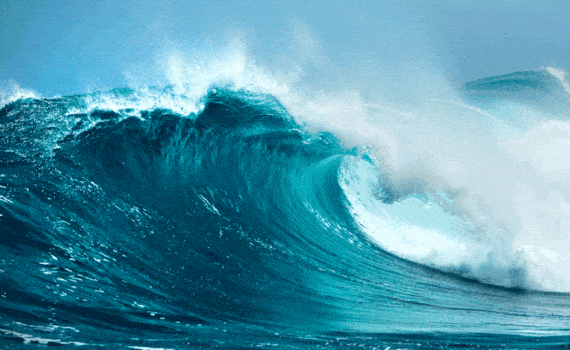Decoding the Rip Current Phenomenon
Rip currents, often referred to as the “rivers of the ocean,” are powerful, localized currents that flow swiftly away from the shoreline, perpendicular to the beach. These enigmatic forces of nature are formed when waves push water towards the shore, and the accumulated water seeks an escape route, carving channels through sandbars or other underwater structures.
Despite their ominous reputation, rip currents are not the terrifying “undertows” that many perceive them to be. They do not pull swimmers beneath the surface but rather whisk them away from the shallows and into deeper waters. The real danger lies in their incredible speed, with some rip currents reaching a staggering 8 feet per second – faster than an Olympic swimmer.
Rip Current Varieties
Not all rip currents are created equal. These powerful streams come in various forms, each with its unique characteristics:
- Fixed Rips: The most common variety, these rips occur in deep channels between sandbars and can persist for days, weeks, or even months.
- Flash Rips: Ephemeral and unpredictable, these rips appear and disappear rapidly, often triggered by sudden shifts in sandbar formations or surges in wave size.
- Permanent Rips: Influenced by topographical features like piers, cliffs, or groins, these rips are anchored to immovable obstructions, creating consistent offshore flows.
- Traveling Rips: Initially flowing parallel to the shoreline, these rips eventually veer seaward, carrying unsuspecting swimmers and surfers with them.
The Telltale Signs: Spotting a Rip Current
Identifying a rip current is crucial for any beach-goer, especially surfers who spend extended periods in the water. While rips can be elusive, there are telltale signs to watch for:
Visual Cues
- Gaps in Breaking Waves: Look for narrow channels where waves fail to break, creating a corridor of calmer, darker water extending offshore.
- Discolored Water: Rip currents often stir up sand from the ocean floor, resulting in murky, discolored water.
- Debris Trails: Floating objects like foam, seaweed, or driftwood being carried seaward can indicate the presence of a rip current.
- Choppy Surface: The convergence of offshore and onshore currents can create a turbulent, rippled surface texture unique to rip currents.
Environmental Factors
- Sandbars and Channels: Rips frequently form in deep channels between sandbars, where water accumulates and seeks an escape route.
- Structures: Man-made structures like piers, jetties, or groins can disrupt the natural flow of water, creating permanent rip currents.
- Beach Topography: Certain beach shapes and contours are more conducive to rip current formation, so familiarize yourself with your local surf spot.
When the Current Catches You: Survival Strategies
Even the most experienced surfers can find themselves ensnared by a rip current’s powerful grip. In such situations, staying calm and following these survival strategies can mean the difference between a harrowing experience and a safe return to shore.
Don’t Fight the Rip
The cardinal rule when caught in a rip current is never attempt to swim against it. Even the strongest swimmers will quickly exhaust themselves trying to overpower the relentless offshore flow. Instead, conserve your energy and float calmly.
Signal for Help
If lifeguards are present, immediately raise your arm and call out for assistance. Their trained eyes can spot distressed swimmers, and they have the equipment and expertise to perform rescues. If other surfers or beachgoers are nearby, try to attract their attention as well.
Escape Sideways
Rip currents are typically narrow, rarely exceeding 25 meters in width. By swimming parallel to the shoreline, you may be able to escape the rip’s grip and reach an area where waves are breaking, indicating shallower waters.
Ride It Out
If all else fails, allow the rip current to carry you until it dissipates. Most rips lose their strength beyond the surf zone, at which point you can attempt to swim back to shore, using the breaking waves to assist your return.
Surf Smarts: Staying Safe in the Lineup
While rip currents pose a significant threat, surfers can mitigate risks by adopting a few simple precautions and best practices.
Seek Local Knowledge
Before paddling out, consult with lifeguards, experienced locals, or surf instructors about the specific conditions and potential hazards at your chosen surf spot. Their insights can be invaluable in avoiding potential rip current zones.
Surf with a Buddy
The buddy system is a time-honored tradition in surfing, and for good reason. Having a partner not only enhances safety but also allows for mutual support and assistance should either of you encounter trouble in the water.
Respect Your Limits
Be honest with yourself about your surfing abilities and physical fitness. If you’re a beginner or feel fatigued, it’s best to avoid challenging conditions or areas known for strong rip currents.
Stay Hydrated and Energized
Dehydration and fatigue can severely impair your ability to handle rip currents or other ocean hazards. Ensure you’re well-hydrated and have sufficient energy reserves before hitting the waves.
The Lifeguard’s Perspective: Flagging Systems and Beach Safety
Many beaches around the world employ flagging systems or signage to communicate water conditions and potential hazards to beachgoers. Understanding these systems can help you make informed decisions about when and where to enter the water.
Flagging Systems
- Red and Yellow Flags: In countries like Australia, New Zealand, and the UK, these flags mark the safest areas for swimming, with the rule being “swim between the flags.”
- Color-Coded Flags: In the United States and other regions, different colored flags indicate varying levels of water safety, with red typically signaling dangerous conditions and green indicating safe swimming areas.
Beach Signage
Many beaches feature informative signage that warns of potential hazards, including rip currents. Always take the time to read these signs and heed their advice, as they can provide crucial insights into local water conditions.
Beyond the Surf Zone: Exploring Rip Current Science
While rip currents have long been a source of fascination and fear for beachgoers, modern science has shed light on the intricate dynamics that govern these powerful currents.
Rip Current Formation
Rip currents are born from the interplay between waves, sandbars, and beach topography. As waves break and dissipate their energy in the surf zone, the resulting water accumulates and seeks the path of least resistance back to the open ocean, carving channels through sandbars or other underwater structures.
Circulation Patterns
Far from being one-way streams, rip currents are part of a complex circulation pattern that includes feeder currents and offshore return flows. This intricate system ensures a continuous exchange of water between the surf zone and the open ocean.
Predictive Modeling
Advancements in oceanographic modeling and remote sensing technologies have enabled scientists to better predict the formation and behavior of rip currents, potentially paving the way for more effective warning systems and beach safety measures.
The Global Impact: Rip Current Statistics and Awareness
Rip currents are a global phenomenon, posing risks to swimmers and surfers across the world’s coastlines. Raising awareness and promoting education about these powerful currents is crucial for reducing the staggering number of rip current-related incidents each year.
By the Numbers
- Rip currents account for over 80% of rescues performed by beach lifeguards in the United States.
- In the United Kingdom, over 60% of incidents involving the Royal National Lifeboat Institution (RNLI) lifeguards are related to rip currents.
- Globally, rip currents are responsible for hundreds of drownings and more than 100,000 lifeguard rescues annually.
Awareness Campaigns
Organizations like the National Oceanic and Atmospheric Administration (NOAA), Surf Life Saving Australia, and the RNLI have launched extensive awareness campaigns to educate the public about rip currents. These initiatives aim to dispel myths, provide survival tips, and ultimately reduce the number of rip current-related tragedies.
Embracing the Challenge: Surf Culture and Rip Currents
For many surfers, the thrill of riding waves is inextricably linked to the challenge of navigating rip currents. These powerful currents have become an integral part of surf culture, inspiring respect, caution, and a deep appreciation for the ocean’s raw power.
Surfing Legends and Rip Current Tales
From legendary big wave riders to local heroes, the surfing community is replete with stories of daring escapes, harrowing rescues, and hard-earned lessons learned from encounters with rip currents. These tales serve as cautionary reminders and sources of inspiration for surfers of all levels.
Surf Etiquette and Rip Current Awareness
Within the tight-knit surf community, there exists an unwritten code of conduct that emphasizes awareness, preparedness, and mutual support when it comes to rip currents. Experienced surfers often share their knowledge with newcomers, passing down valuable insights and survival strategies.
The Allure of the Challenge
For some, the very presence of rip currents adds an extra layer of excitement and challenge to the surfing experience. Navigating these powerful forces requires skill, courage, and a deep respect for the ocean – qualities that many surfers strive to cultivate.
Conclusion: Riding the Waves with Confidence
Rip currents are a force of nature that demand respect and preparation from anyone venturing into the ocean. By understanding their dynamics, recognizing their telltale signs, and mastering survival strategies, surfers and beachgoers alike can confidently enjoy the thrill of riding waves without succumbing to the menacing pull of these powerful currents.
Remember, knowledge is power, and in the realm of rip currents, that knowledge can mean the difference between a harrowing ordeal and a safe, exhilarating surf session. Embrace the challenge, respect the ocean, and ride the waves with confidence – the keys to mastering the menacing pull of rip currents.




